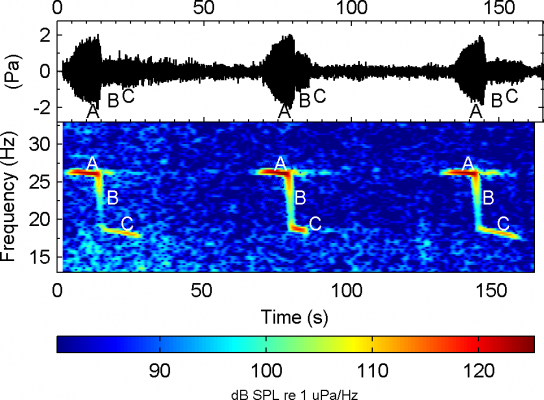Long distance acoustic monitoring:
the IWC Southern Ocean Research Project (SORP)
A complex and multi-faceted acoustics research programme has been endorsed by the IWC Scientific Committee. Whales are often easier to hear than to see, and underwater acoustic monitoring has been used for many years by scientists trying to learn more about these inaccessible animals.
The latest research has pioneered and validated new methodology, using sono (acoustic) buoys to locate and track whales in real time, and over distances of hundreds of kilometres. This increases the efficiency of attempts to encounter and study cetaceans.
Accessibility is another significant development. Previously, several bespoke and often incompatible software systems were needed to analyse the signals received from sonobuoys. This research programme successfully trialled a single, open source and agile software package which simplifies analysis and eliminates the need to invest in multiple software solutions.
Each sonobuoy contains three acoustic sensors, a magnetic compass, signal processing circuitry and a VHF radio transmitter. The buoys are placed at regular intervals within an established area. The recent research validated all aspects of the new methodology over three research voyages, studying blue, pygmy blue, and Antarctic blue whales off New Zealand, the south coast of Australia, and in the Southern Ocean respectively.
Multi-disciplinary teams successfully addressed a range of complications. The potential problem of buoys drifting, and transmitting from unknown locations, was solved via a three stage process. Data was first collected which enabled drift to be estimated. Scientists then derived a statistical method of predicting potential speed and direction of drift. Finally, this statistical correction was built into the programme, tested, and proven to solve the problem and increase the accuracy of whale location estimates.
Other challenges included the need to eliminate non-whale sounds which were also transmitted from the buoys (such as electrical noise from the transmitter itself), and the need to correct ‘compass drift’ when operating very close to the magnetic south pole. Each complication was successfully countered, and a suite of research papers covering all aspects of the programme was presented to the IWC Scientific Committee. They endorsed the work, concluding that this research confirms the potential to detect whales over 1000km away, and makes advances towards improved abundance estimates for Antarctic blue whales.
The Scientific Committee encouraged continuation of this research. The acoustic tracking methods and resulting data will directly benefit two ongoing SORP projects; the 'Acoustic Trends Project,' and the 'Antarctic Blue Whale Project.' The SORP 'Acoustic Trends' team intend to extend the existing multinational and multidisciplinary team to create a circumpolar acoustic monitoring network. The SORP 'Antarctic Blue Whale Project' also plan to adopt these acoustic tracking methods on further research voyages over a minimum twelve year period, in order to reach reliable abundance estimates for the rare and elusive Antarctic blue whale.
For more information on the SORP programme click here.

